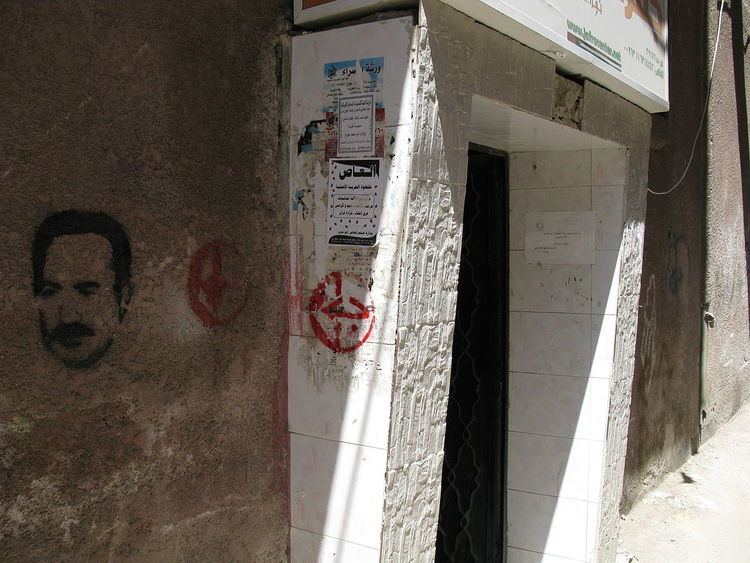Area 211 ha Area code 11 Established 1957 | Local time Monday 9:50 AM | |
 | ||
Weather 12°C, Wind NE at 8 km/h, 55% Humidity Restaurants Nabil Nafisa Sweets, Hamdan Patisserie, Hot Pie | ||
Help refugees in yarmouk camp syria
Yarmouk Camp (Arabic: مخيم اليرموك) is a 2.11-square-kilometre (0.81 sq mi) district of the city of Damascus, populated by Palestinians, with hospitals and schools. It is located 8 kilometres (5.0 mi) from the center of Damascus and inside the municipal boundaries but when established in 1957, it was outside the surrounding city. Yarmouk is an "unofficial" refugee camp; it was home to the largest Palestinian refugee community in Syria. As of June 2002, there were 112,550 registered refugees living in Yarmouk.
Contents
- Help refugees in yarmouk camp syria
- Map of Al Yarmouk Camp Damascus Syria
- Establishment
- Operation and living
- During Syrian Civil War
- References
Map of Al Yarmouk Camp, Damascus, Syria
During the Syrian Civil War, Yarmouk camp became the scene of intense fighting in 2012 between the Free Syrian Army and the PFLP-GC supported by Syrian Army government forces. The camp then was consequently taken over by various factions and was deprived of supplies, resulting in hunger, diseases and a high death rate, which caused many to leave. By the end of 2014, the camp population had gone down to just 20,000 residents.
In early April 2015, most of the Yarmouk camp was overrun by the Islamic State of Iraq and the Levant, sparking armed clashes with Palestinian militia Aknaf Bait al-Maqdis, associated with Hamas and the Muslim Brotherhood. According to the Syrian Observatory of Human Rights, the ISIL attack resulted in 40 ISIL militants killed; Palestinian sources reported about 12 camp residents killed, while Syrian source reported 13 killed; and independent sources also confirmed two fatalities from mortar fire in an adjacent Damascus area. It was reported that despite Palestinian militia resistance and parallel bombing by the Syrian Air Force, ISIL still controlled 90% of the camp by 6 April. The situation in the camp came to the attention of the UN Security Council, which aimed to discuss the prospects of some 18,000 residents of the occupied camp.
Establishment
Yarmouk was established in 1957 on an area of 2.11 square kilometres (0.81 sq mi) to accommodate refugees who were squatters. Though it was not officially recognized as a refugee camp, road signs leading to this sector of the city read "Mukhayyam al-Yarmouk", meaning "Yarmouk camp". Administratively, Yarmouk is a city (madina) in the Damascus Governorate.
Operation and living
Over time, refugees living in Yarmouk improved and expanded their housing. Currently, the district was densely populated, with cement block homes and narrow streets. Two main roads were lined with shops and filled with service taxis and microbuses that ran through the camp. The BBC wrote that, although Yarmouk "is identified as a camp, there are no tents or slums in sight. It is a residential area with beauty salons and internet cafes".
Living conditions in Yarmouk appeared to be better than in Palestinian refugee camps in Syria, and residents of the camp numbered many professionals— doctors, engineers and civil servants, as well as many casual laborers and street vendors.
There were four hospitals and a number of government-run secondary schools. UNRWA operated 20 elementary schools and eight preparatory schools in the camp, and sponsors two women's program centers. There were three UNRWA health care centers in Yarmouk, two of which received upgrades in 1996 with contributions from the government of Canada. In 1997, six schools were upgraded with contributions from the government of the United States, and a kindergarten was built with funds from the government of Australia. In 1998, the UNRWA was also able to construct a health center funded by the government of the Netherlands. There was another Health Center whose expertise is devoted to prevention and treatment of thalassemia. The Center was built in 2009 thanks to funds provided by the Spanish Agency for International Development Cooperation (AECID).
During Syrian Civil War
During the Syrian Civil War, Yarmouk camp became the scene of intense fighting between the Western-backed rebel Free Syrian Army and its Palestinian ally Liwa al-Asifa on the one hand, and the Popular Front for the Liberation of Palestine – General Command (PFLP-GC) supported by Syrian Army government forces on the other. Subsequently the Syrian Army besieged the camp, leading to many leaving the area and causing a significant deterioration in conditions for the more than 18,000 Palestinian refugees and other Syrians remaining inside the camp, whom the UN describes as living in "complete deprivation".
On 1 April 2015, Islamic State of Iraq and the Levant (ISIL) fighters entered the camp from the Hajar al-Aswad district, sparking clashes with Aknaf Beit al-Maqdis and the Free Syrian Army. ISIL initially took over much of the camp, but was later pushed back from some areas, before eventually regaining control. On April 2, it was reported that ISIL was in control of the entirety of the Yarmouk camp. The situation in the camp came to the attention of the UN Security Council, leading to discussions about the situation of some 18,000 residents of the occupied camp. It has been reported that many civilian Palestinians have been killed during the fighting. In July 2015, the UN quietly removed Yarmouk from its list of besieged areas in Syria, despite not having been able deliver aid there for four months, and declined to explain why it had done so.
By April 2016, there are only between 7,000 and 8,000 residents left in the camp due to militant fighting within the camp, conscription by the regime and the use of wide area effect weapons such as barrel bombs. Former residents are displaced to other areas of Syria or have fled outside, including Lebanon and Europe.
